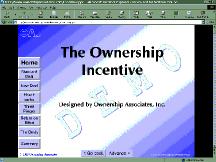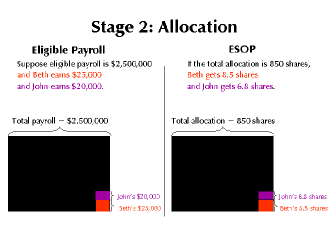Ownership Associates offers versions of some of our training programs in an interactive web-based format.
 View an interactive introduction to e-learning tools and how they work. (This is a Microsoft PowerPoint Show file and will work most effectively with high-speed internet access.)
View an interactive introduction to e-learning tools and how they work. (This is a Microsoft PowerPoint Show file and will work most effectively with high-speed internet access.)
You can also view a demonstration training module, which is an e-learning version of our Ownership Incentive module.
Ownership Associates currently offers versions of two of our training programs in an interactive web-based format.
 This e-learning tool is designed for people from all levels of a company's workforce and seeks to increase understanding of the ESOP as well as building trust in the legitimacy of the ESOP.
This e-learning tool is designed for people from all levels of a company's workforce and seeks to increase understanding of the ESOP as well as building trust in the legitimacy of the ESOP.
It addresses common misconceptions and fears about employee ownership, and gives employees reasons to be enthusiastic about being ESOP participants. It covers five topics:
- A Capsule History of ESOPs
- The Current ESOP Landscape
- Ownership and Personal Assets
- ESOP Basics: Who Runs the ESOP?
- ESOP Basics: Participation, Vesting, Allocation and Distribution
This module generally take 30 to 45 minutes, depending on the viewer.
This module covers a broad range of topics designed for people who need to support and communicate employee ownership to others. It draws on a number of sources: Ownership Associates' experience consulting with employee-ownership companies, data collected from the Ownership Culture Survey, and research by academics. This e-learning tool is intended to provide a useful interplay between hands-on management guidelines and the most relevant research.
It generally takes between 45 and 60 minutes, depending on the style of the viewer. The major content areas are:
- Research: The effects of employee ownership on company performance, employee retirement assets, etc. What factors make the difference in successful employee-ownership companies? (See also our Briefing Papers and index of online research.)
- The Psychology of Employee Ownership: The roots of a feeling of ownership and how to make the most of the powerful associations people have with the concept of ownership.
- Managing Expectations: Employee expectations are the source of the employee-ownership competitive advantage, but when poorly handled, they can contribute to disappointment. This section also discusses ways to link employee goals for ownership with the company's goals.
- Cynics and Believers: What makes people enthusiastic -- or cynical -- about ownership? What types of ownership cynicism are there? This section suggests some concrete steps to maximize ownership enthusiasm at your company. (See also Ownership Cynics.)
- Common Pitfalls: There are a number of consistent patterns in the challenges and setbacks companies may experience in becoming employee-owned. This section describes common pitfalls and suggests ways to avoid them. (Some are described in Making an ESOP Work for You.)
- Building and Communicating a Vision: The best way to respond to cynicism and to employee expectations is to have a clear vision about what ownership means. This section shares some tools and gives some examples about how companies have defined and communicated employee ownership in a powerful, clear, and inspiring manner.